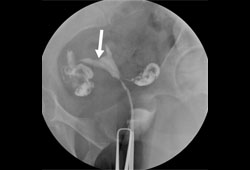月经过多通常是指每个月经周期出血量≥80 mL。[1]Oehler MK, Rees MC. Menorrhagia: an update. Acta Obstet Gynecol Scand. 2003;82:405-422.http://www.ncbi.nlm.nih.gov/pubmed/12752071?tool=bestpractice.com由于月经出血量较难衡量,该术语通常用于描述月经期出血极多或月经期过长(>1周)。育龄期女性多见。月经过多的发生率随年龄增长,30-49岁女性的发生率最高,在该年龄段,每年大约每20名女性中就有一名因出血过多而咨询全科医生。[2]Philipp CS, Faiz A, Dowling N, et al. Age and the prevalence of bleeding disorders in women with menorrhagia. Obstet Gynecol. 2005;105:61-66.http://www.ncbi.nlm.nih.gov/pubmed/15625143?tool=bestpractice.com[3]Jayasinghe Y, Moore P, Donath S, et al. Bleeding disorders in teenagers presenting with menorrhagia. Aust N Z J Obstet Gynaecol. 2005;45:439-443.http://www.ncbi.nlm.nih.gov/pubmed/16171484?tool=bestpractice.com[4]Day Baird D, Dunson DB, Hill MC, et al. High cumulative incidence of uterine leiomyoma in black and white women: ultrasound evidence. Am J Obstet Gynecol. 2003;188:100-107.http://www.ncbi.nlm.nih.gov/pubmed/12548202?tool=bestpractice.com[5]Garside R, Stein K, Wyatt K, et al. The effectiveness and cost-effectiveness of microwave and thermal balloon endometrial ablation for heavy menstrual bleeding: a systematic review and economic modelling. Health Technol Assess. 2004;8:1-155.https://www.ncbi.nlm.nih.gov/pubmedhealth/PMH0015110/http://www.ncbi.nlm.nih.gov/pubmed/14754561?tool=bestpractice.com
阅读更多AAFP: heavy periods (menorrhagia)
流行病学
在英国,20%的女性在60岁前因月经过多切除子宫,但病理学检查显示40%的子宫未见异常。[6]Maresh MJ, Metcalfe MA, McPherson K, et al. The VALUE national hysterectomy study: description of the patients and their surgery. BJOG. 2002;109:302-312.http://www.ncbi.nlm.nih.gov/pubmed/11950186?tool=bestpractice.com在美国,20%-25%的健康绝经前女性出现过异常子宫出血。[7]Farquhar CM, Steiner CA. Hysterectomy rates in the United States 1990-1997. Obstet Gynecol. 2002;99:229-234.http://www.ncbi.nlm.nih.gov/pubmed/11814502?tool=bestpractice.com在非西方国家,尚不清楚月经过多的发生率。25%的妇科手术的原因为异常子宫出血。[8]Carlson KJ, Nichols DH, Schiff I. Indications for hysterectomy. N Engl J Med. 1993;328:856-860.http://www.ncbi.nlm.nih.gov/pubmed/8357364?tool=bestpractice.com
病理生理学
在正常周期的月经出血期间,卵巢的雌孕激素诱导产生前列腺素、细胞因子、基质金属蛋白酶 (matrix metalloproteinase, MMP)。这些都直接影响子宫内膜功能层的周期性再生。[9]Sivridis E, Giatromanolaki A. New insights into the normal menstrual cycle-regulatory molecules. Histol Histopathol. 2004;19:511-516.http://www.ncbi.nlm.nih.gov/pubmed/15024712?tool=bestpractice.com异常子宫出血代表这种有序的再生被破坏。[10]Munro MG. Abnormal uterine bleeding in the reproductive years: pathogenesis and clinical investigation. J Am Assoc Gynecol Laparosc. 1999;6:393-416.http://www.ncbi.nlm.nih.gov/pubmed/10548698?tool=bestpractice.com在月经期出血严重的女性中,经常发现螺旋小动脉的血管-平滑肌细胞层变薄、前列腺素分泌向血管舒张性前列腺素偏移、子宫内膜的凝血机制紊乱。在通常正常的排卵性月经周期中,可能发生月经过多。严重出血伴月经周期不规则更可能反映无排卵性出血,可由一系列不同的疾病导致。月经过多的女性可能并没有任何结构、激素、血液或其他系统的异常。[11]Speroff L, Fritz M. Dysfunctional uterine bleeding. In: Speroff L, Fritz M, eds. Clinical gynecologic endocrinology and infertility. 7th ed. Philadelphia, PA: Lippincott Williams and Wilkins; 2005:547-571.



